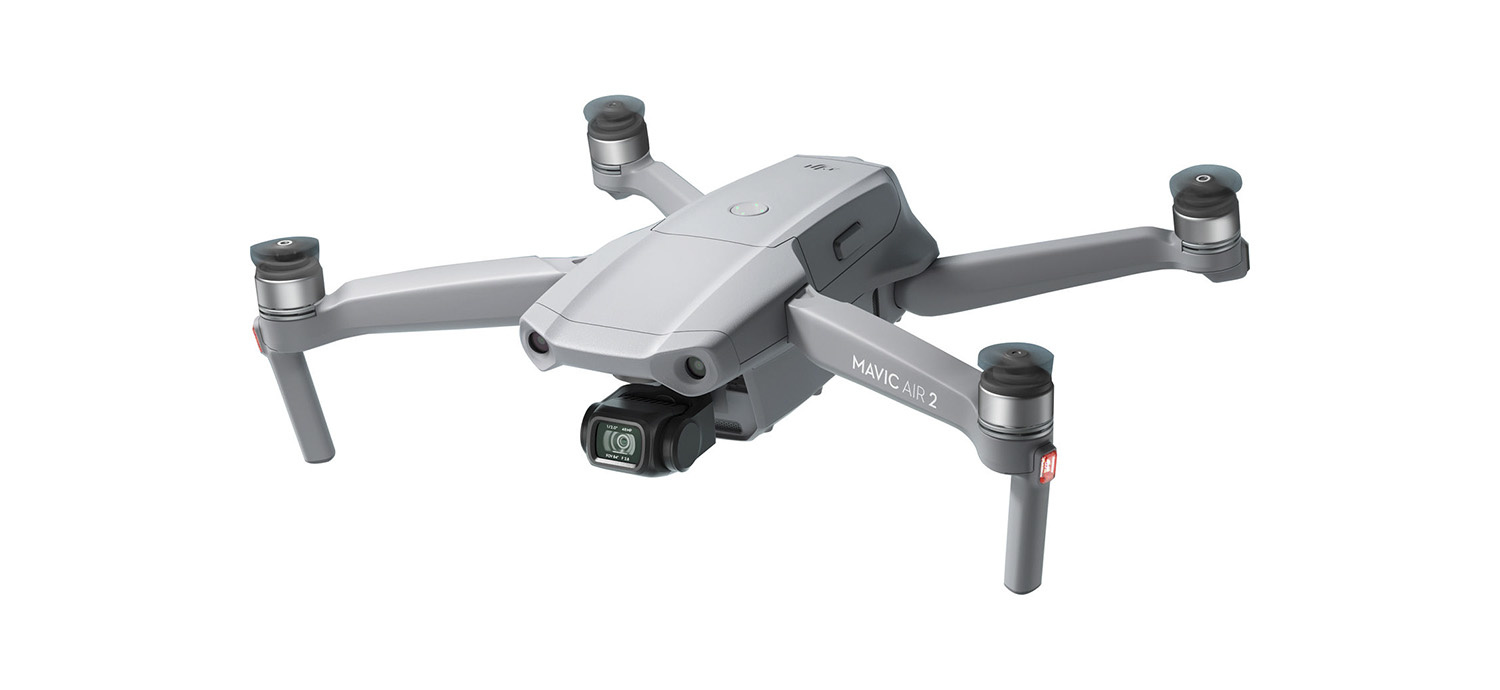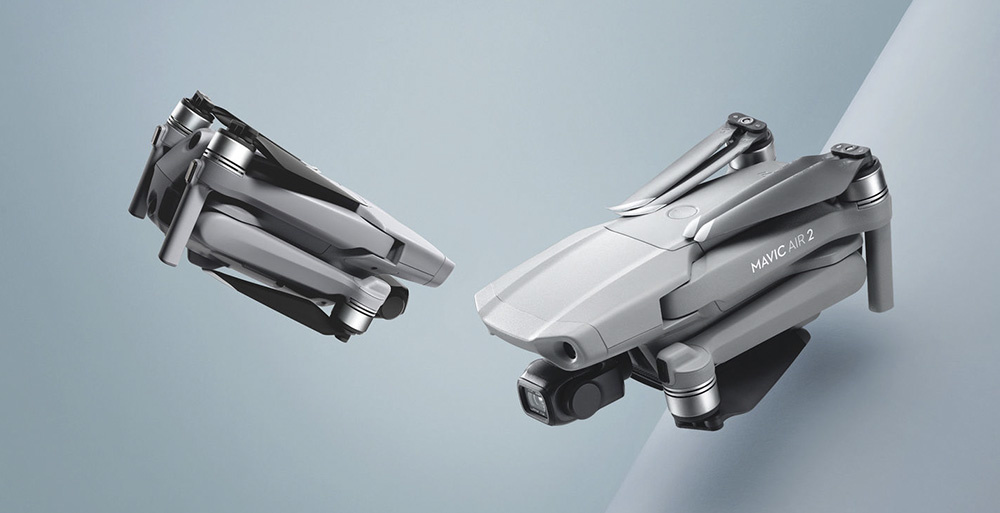Depending on what you need, there's a DJI drone for everyone. For most, you'll find that drone somewhere in DJI's Mavic lineup, which is now bolstered with improvements to its mid-range offering as its new Mavic Air 2 takes to the skies with a number of improvements borrowed from its pro relatives.
First and foremost, we have to get excited about improvements to image quality. Resolution is one thing, but you can record 8K video with a billion artifacts, and it'll look worse than a clean standard HD image. While 100 Mbps is often thought of as a good starting point or minimum for 4K video shot in the H.264 codec that's been popular for the last five years or so, the Mavic Air 2 bumps this up from its predecessor's specs to a much-appreciated 120 Mbps. That may not seem like much of an increase, but that's 20 percent more data you can capture for your 4K60p videos (yes, that's new for the Air 2, although HDR is limited to 4K30p), which are going to need everything they can get since you're doubling the frames each second.
Most exciting, however, is the inclusion of the more efficient H.265 codec normally reserved for its $1,000-and-up drones such as the Mavic 2 series. The inclusion of the H.265 video codec, which can be around 50 percent more efficient than H.264, means you'll see less quality drop-off when flying your drone over forests, water, and other scenes with thousands of small details — all the kinds of scenes drones are more likely to capture than in your typical from-the-ground shooting. Coupled with the increased 120 Mbps bitrate, the Air 2 should help keep up and then some in the new 4K60p mode. Video recording at 1080p now goes up to 240 fps for ultra-slow-motion shooting.
In addition to the improved video quality, the Mavic Air 2 can also stitch together 12 MP images to create 48 MP panoramas, which, along with 8K hyper-lapse videos, should shine on its bigger 1/2-inch sensor (the Mavic Air had a 1/2.3-inch sensor), although that's still half the diagonal (or 1/4 the area) of the top-end consumer Mavic 2 series' 1-inch sensor. Still, the increase over the original Air represents a nearly 10 percent improvement, which we can call a fair bump. Since the sensor maintains the same resolution, we can expect that 10 percent to show itself more in overall image quality improvements such as decreased noise and better low-light performance. Complementing the additional hardware improvements is the addition of the D-Cinelike flat color profile, which was also previously limited to the higher-end Mavic drones.
The Mavic Air 2 features a new controller that comes standard. While it's larger, the thumbsticks are removable, your phone now mounts above the controller (which makes more sense), and, most importantly, the new controller supports the higher-end series' OcuSync 2.0, which should increase your range from the 2 km of the Air's original W-iFi remote to up to 10 km with this new setup. Thanks to increased battery life now up to 34 minutes and the same top speed of up to 68 kph (42 mph), you can actually take advantage of that, all while sending back 1080p video back to your controller.
For safety, AirSense also now comes on the Mavic Air 2. By sensing communications from nearby commercial and private helicopters and airplanes, the Mavic Air 2 can now sense if and when it is too close or within the flight path of other aircraft, which should help warn you when you're too close to other aircraft so you can maneuver and avoid dangerous collisions. Along the same lines, standard downward, forward, and rear-facing obstacle avoidance should give you additional peace of mind (although it's important to note these are not foolproof and you still need to remain aware of the drone's surroundings at all times). But the Air 2 still omits the less necessary but still useful upward and side-pointing obstacle avoidance systems.
Advanced Pilot Assistance Systems (APAS) 3.0 is smoother and more effective than before at mapping and avoiding obstacles in its path. And other smart features are now smarter with more advanced tracking modes than ever before thanks to Active Track 3.0, Spotlight 2.0, and Point of Interest 3.0.
At $799, the Mavic Air 2 is the same price as its predecessor was at launch over two years ago, but this time comes with a lot more bang. The Fly More Combo with two additional batteries, three additional sets of propellers, and a few other additional accessories such as ND filters will run you $988. The Mavic Air 2 ships to the U.S. mid-May and is available for pre-order today. Buyers in China can get the Air 2 today.
DJI Drone Series Overview
To get a sense of where the Air 2 fits in, it's important to quickly review the Mavic lineup, which is DJI's most extensive and can be more or less thought of as the agile, portable, prosumer drone. Below all Mavic drones is the discontinued, cute, lightweight, and affordable Spark. Somewhere alongside the Mavics is the Phantom lineup. And above all, there are the Inspire and other commercial series.
For current models within the Mavic, before today, the Mavic Mini is at the lower end, where the original Mavic Air was just above it with a significantly better body and improved video features making it what a consumer might upgrade to or what a prosumer might settle for. Since the price of the Air 2 is the same as it was for the original, that fact probably doesn't change today: those same buyers will just get more for their money now that we're looking at tech that's two years newer. But when you really examine everything the way it currently sits, DJI will have to seriously upgrade the lines above to keep them relevant in the face of the Air 2 announced today.
After the Air 2 and increasing slightly in size, weight, and expense, we still have the Mavic Pro and Mavic 2, which each come in their own variants with minor differences. Compared to the original Air, the Mavic Pro and Mavic Pro Enterprise both added OcuSync 2.0, although Air 2 now brings parity to that. The only real reason to get the Pro or Pro Platinum over any of the Airs would be for the longer flight time of 30 minutes. But that is now also moot with the increased flight time of the Air 2. And the Pro models actually have aging specifications, such as a limited 60 Mbps bitrate. The big change for image quality is the inclusion of H.265 and additional color profiles in the entire Mavic 2 series, which come in Pro, Zoom, and Enterprise variants. The Pro is more expensive than the Zoom, but they're both simply different offerings. One is not necessarily better than the other, although the Pro does have the largest 1-inch 20 MP sensor in a camera unit with the Hasselblad brand name (DJI owns a major stake of Hasselblad). The Zoom, on the other hand, offers more creative control with 2x optical zoom functionality but maintains the smaller 1/2.3-inch sensor. The Enterprise model is not filmmaker oriented and offers module compatibility with add-ons such as spotlights, loudspeakers, etc., for emergency and government services. You can get more comparison information from DJI here.
As we can see, Mavic Air 2 is a great update for the Mavic system. Higher bitrate recording will lead directly to enhanced image quality that should outshine all past generations, in many ways including the higher-end Mavic 2 lineup with the same H.265 and enhanced color profile capabilities, but perhaps not quite the the Mavic 2 Pro's 20 MP 1-inch sensor. But we're talking a nearly 100-percent premium over the Mavic Air 2 to add that larger sensor, which not everyone will need. And the Air 2 is still smaller, lighter, lasts longer, and can go farther. For most, the Mavic Air 2 hits the sweet spot of price and performance at the moment. All these amazing features leaves you wondering, though: If the Air can become better than the Mavic 2 Pro, what else are we in for in the not-so-distant future?












I remember when I bought my first drone and then returned it without ever flying it. https://www.youtube.com/watch?v=8AB0FFuvanQ
Talk about a downer video....
Yup and it's what most people don't even consider when buying a drone.
There are actually a lot of fair points in here. Shockingly, I don't think it's QUITE that locked down in California. Yes, the same issues exist from a commercial use standpoint. And they REALLY need to work on that from a legislative perspective. They should create a whole new class of license (maybe even a test, fine, but simplified) for drone flights under 200 or 400 or so feet. But it at least seems like in California we can legally fly as hobbyists in a few more areas...looks tough in Florida...